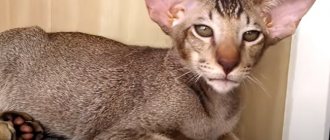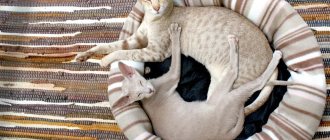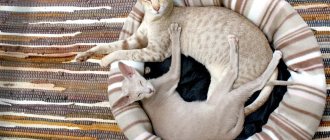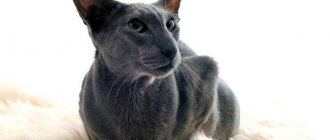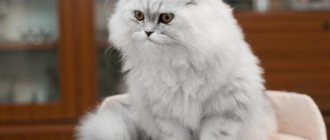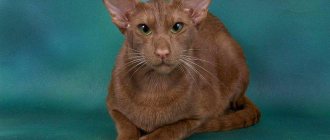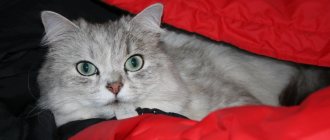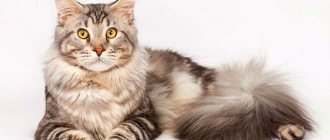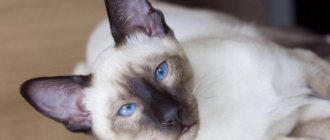Cinnamon is a rare color among the British
My love for the cinnamon-colored British sparkled in me from the very first glance at the photograph of our then very little Umochka.
This girl immediately captivated me with her not childishly serious look and short plush fur coat of a very warm and light shade of chocolate. Today, Uma has a coat of a beautiful and rich color of freshly ground cinnamon. And its stunning color is called cinnamon, which is translated from English as “cinnamon”. The cinnamon color was first discovered in Abyssinian cats. And the discoverer of this exclusive was the Dutch breeder of Abyssinian cats Maria Falkena-Rohrle, the founder of the Van Mariendaal breed line. But before, not far from 1980, Maria heeded the advice of the chairman of the independent Dutch club Ineke Zegers, to submit an official application for recognition of the color she discovered. She did a huge amount of work over almost a decade and a half and already had more than 25 cats in her cattery with a strange “cinnamon cookie” color.
Thus, on April 19, 1980, cinnamons were recognized by the NKFV club as “foreign shorthairs.” And in 1982, some independent Dutch clubs recognized the fawn color (translated from English as “fawn”) as a lightened version of the cinnamon color. In Orientals, the cinnamon color was confirmed by FIFE in 1991, and in Siamese only in 2004, although in the Oriental breed it was also obtained by 1980.
Cinnamon , and its lightened variant fawn , are currently very popular and fashionable colors among British Shorthair cats. If we compare them with the classic colors of the British, then we can firmly say that cinnamon and fawn are rare and new colors in the British breed. Received, by decision of the WCF General Assembly, official recognition only from the beginning of January 2009.
Cinnamon-colored cats appeared in the British breed thanks to the efforts of several European catteries, which, through experimental interbreeding of British cats with representatives of cinnamon-bearing breeds such as Somalis, Orientals, and Siamese, achieved the seemingly impossible by mating complete opposites with each other.
Work on this complex and amazingly beautiful color is ongoing to this day. Breeders of many Russian and foreign nurseries, through competent selection of pairs of sires, make a lot of effort to improve the type of British kittens and cinnamon-colored cats.
Representatives of the British breed of cinnamon color have, noticeably different from the chocolate color in their warm and light shade, red-brown coat color with a copper tint and a slightly lighter yellow-brown undercoat. The paw pads and nose surface of cinnamons are colored the color of cocoa heavily diluted with milk with a light pink tint. In kittens, they have an even more delicate and lighter shade of pink, similar to the skin color of a small child. I would call this color beige-pink. However, like cats of fawn color. But during times of stress, the paw pads and nose of the British cinnamon color change, they darken to the color of milk chocolate with a slight hint of red.
The Cinnamon and Fawn colors are definitely among the unusually beautiful colors in the British breed. And what’s very nice is that they can be found for a long time in the most diverse and interesting variations - these are cinnamon turtles, fawn turtles, cinnamon bicolors, fawn bicolors, cinnamon points, fawn points, cinnamon and fawn tabbies, as well as ticked cinnamons and ticked fawns. In conclusion, I would like to add that, like all children, kittens of any color, regardless of their belonging to a particular breed, are always very cute and funny. But the British dogs of the cinnamon and fawn colors are something surprisingly tender and magical.
Characteristics of an Oriental cat
When looking at Orientals, only a person knowledgeable in felinology can immediately name the signs in which these cats are similar to Siamese. In fact, the standard has long been rewritten, and is intended exclusively for this breed. The characteristics of the breed are as follows:
- narrow, long body;
- long, thin neck;
- small triangular head;
- the muzzle is pointed, the chin is narrow, the nose is wide;
- the connection of the forehead and the bridge of the nose is very smooth;
- large almond-shaped eyes of green (less often blue) color;
- very large, widely spaced ears;
- the front legs are slightly shorter than the hind legs;
- long, thin tail up to 80 cm long.
It should also be noted that Oriental cats are practically devoid of undercoat. The fur is thick and smooth, with a healthy shine.
Definition and a bit of genetics
Cinnamon color appeared relatively recently and is a rare color. The bearer of such an unusual color is the British cat breed. Sometimes you can hear how the color is also called cinnamon, which comes from the word cinnamon. This is not surprising, since the fur is reddish-brown. This color is usually classified as black-brown, determined by the pigment eumelanin.
If we look at the situation from a genetic point of view, then the formula contains a dominant allele B - black , thanks to which it is possible to guarantee the production of a dark pigment. When animals have it, the fur coat is painted in classic colors. We are talking about black or blue. In the latter case, dilution occurs due to the D gene, which is responsible for color dilution.
In this regard, the hair of the coat is poorly filled with eumelanin molecules, which leads to a gray-blue color. When the B – brown allele is additionally present in the color, the color of the animal will be either chocolate or diluted. Lilac color is not uncommon and is even more common than chocolate. At the same time, the presented allele affects the fact that the black pigment is, as it were, displaced from the general structure. This affects the lightening of the brown tone.
Several decades ago it turned out that there is another alley responsible for the color of the coat, its name is BL - brown light - light chocolate. Thanks to it, you can get the cinnamon color in cats.
Care and maintenance
The Oriental cat breed is a clean animal that does not require constant brushing or bathing. Care procedures consist of the following:
- combing during seasonal molting;
- bathing as needed;
- cleaning ears, eyes and teeth.
It is important not to forget about trimming the claws, which is carried out monthly, shortening the keratinized part by no more than 2 mm.
The owner of an Oriental should keep in mind his pet’s special love for flowers in pots. Make sure that there are no poisonous specimens like Dieffenbachia among the plants.
History of origin
If it were not for Maria Falkene, a Dutch breeder of Abyssinian cats, then, probably, the concept of cinnamon would still be unknown. The woman tried red cats with black ones. However, instead of the expected tortoiseshell color, the kittens were born in a completely different shade. Although before this, the offspring were always spotted, because the mating of a black cat and a red cat gives the result in the form of “turtle” kittens.
It took the woman 15 years to breed more than 25 cats. This led to the fact that in 1980, one independent club located in the Netherlands recognized the rare color and gave it the name cinnamon. Two years later, some other clubs recognized the intermediate fawn color.
The breeders, knowing what Falken was doing, decided to breed an unrecognized breed for themselves. Thus, success was achieved in 1980 with the Oriental breed. Their color was officially confirmed by FIFe eleven years later. As for the Siamese breed, cinnamon was officially registered only in 2004. If we talk about the British, the color in the British breed was recognized by the WCF General Assembly in 2009.
Raising an Oriental cat
Due to the fact that the character and temperament of Orientals differ significantly from other breeds, you will have to look for a special approach to them - such are the characteristics of these cats. Be prepared for your pet's excessive talkativeness: Orientals are very sociable, and if constant meowing makes you sad, then it is better to think about a breed of calmer cats.
In addition, the problem can come in the form of early puberty and prolonged estrus. A cat can call for a female all night, but an oriental cat will wither away before our eyes. If breeding work is not planned, then the best solution would be sterilization or castration at the age of 6-8 months.
Orientals are possessive and jealous. They do not get along well with other pets: among those who already lived in the house when the kitten was born, they quickly establish their own order, and they simply consider newcomers as rivals.
The main thing to remember when raising an Oriental kitten is: do not let him take a dominant position, and be consistent in your prohibitions.
The appearance of the cinnamon color in the British breed
As already mentioned, cinnamon first appeared in the Abyssinian breed in the 20th century. At that time, the red color was still known as sorrel. This color is extremely rare among the British. Scientists say that the shade is influenced by the gender of the animal.
Important! Color genes in Abyssinian breeds are not inherited and are not mixed as a result of the mating of a cat with a cat of different shades.
For this reason, the cinnamon color is more often found in the breed.
With the British the situation is different. The reason is that the dominant colors are always black and chocolate. The first ones are a little more difficult to obtain. It often happens that kittens are born charcoal, and at 2-3 months the fur begins to change shade to brown. Therefore, when mom and dad “meet,” you can most often expect chocolate offspring. In some cases, breeders think that they have managed to get worthy British dogs of a rare color, but then it turns out that tabby marks appear on the coat, which put an end to the cinnamon. That is why this color is not even a rarity, but rather an exception.
To breed British cats of a rare shade, you need to try for years and perhaps luck will smile on a persistent breeder.
BRITISH CINNAMON: PHOTOS OF ADULT CATS
Photos of British cats, cinnamon color.
| In our cattery you can “buy a real British kitten.” We have many different colors, we will help you choose and answer all your questions! |
History of color appearance
At the beginning of the twentieth century, cinnamon was known in the Abyssinian cat breed. In those days, red cover was not yet called sorrel. Cinnamon for British cats appeared quite recently and is still considered quite rare. Scientists studying the genetics of red color in a variety of cat species have learned that the sex of the animal has a big influence. It is also interesting that the Abyssinian coat genes have nothing to do with inheritance linked to the sex of the pet.
Maria Falkena is a breeder from Holland who, in the early 60s of the 20th century, imported a couple of red Abyssinians from Britain. The male and female cat, named Delilah and Sothis, were purchased from Dorothy Windsor, where she usually acquired her Falken pets. At that time, cats with red fur had not yet been seen on the continent, so the breeder thought that this pair of animals were also red.
However, outwardly they did not look like that at all. Usually cats with red fur have a reddish tint to their fur, but this couple had it brownish-red, like foxes. Among felinologists, Fakena was quite famous for her willingness to experiment and her curiosity. Since her kittens did not look red, she decided to find out if they were in fact genetically red. So, Maria Falkena bred Dilila with a wild-colored cat called “Nigella Simba.”
What does an oriental cat look like?
Sophistication and grace combined with protruding ears is perhaps a suitable description for the appearance of an Oriental. This is a strong and well-developed animal, without looseness or excessive bonyness. Not a single sign of obesity - this is especially noticeable in short-haired cats. As for the long-haired branch, they look softer compared to their lean counterparts.
Muzzle
Oriental cats are characterized by a flat skull and a long wedge-shaped muzzle with a continuation in the form of large, wide ears: in profile, a long and even line is clearly visible without a single hint of convexity in the area of the visual organs and a break in the line of the nose.
Every feature is pure grace, even the chin: moderately massive, not slanted, together with the tip of the nose it forms a straight line. The eyes are slightly inclined towards the nose due to the cut, but without squinting.
Body type
Orientals are proportionally built: they are slender cats with a rather long body. His indicators fully comply with the established standard, including a toned stomach and graceful oval paws. The tail is long in both subspecies, thin even at the base, whip-shaped.
Coat and color
Orientals always have the longest hair on their tail. Otherwise, it is of medium length and fits snugly to the body. Quite thin. Due to the missing undercoat, it looks half as long as it actually is.
The colors are very varied. There are several main groups:
- solid;
- shaded;
- smoky;
- tortoiseshell;
- bicolor;
- tabby
The colors are even richer. While pure chocolate shades are rare among other cat breeds, they are quite common among Orientals. Of course, there are other options:
- ebony;
- Havana;
- lilac;
- blue;
- cinnamon;
- red;
- cream;
- faun.
In addition to the listed variety, there is another, special color of oriental cats - white. There is not the slightest hint of yellowness in it, and the eyes of its owners are blue or green.
Features of color
Cinnamon is a rare and new coat color in cats, it has warmer tones than chocolate coat color.
It appeared due to the oxidation of melanin by the bl gene. The paw pads of such cats and cats become pinkish-brown, almost beige, as does the nose. Cinnamon is a much lighter color than chocolate, rarely with a brownish-reddish sheen. It often happens that a chocolate kitten’s fur is slightly lighter than that of an adult cat, which can be seen in the photo below.
The breeder is happy that he was lucky and a cinnamon was born. There's really no need to rush if the animal's paw pads and nose are brown. Cinnamon is classified as an undiluted color D, while its lightened version is called faun or “fawn.” Next in the video we offer you to look at the owner of such wonderful fur.
Differences from similar colors
It often happens at shows lately that cats from a red coat could be converted to cinnamon. This can once again prove that it is complex and popular. However, in this case, the question may arise as to how judges distinguish cinnamon from other coat colors in kittens. Cats that can be classified as red coats have a red coat and an orange undercoat. Lighter cats can boast a beige undercoat.
Darker pets may have a brick-gray coating on their paws, tail, chin, and so on. That is, in places where there is less undercoat and the hair itself is shorter. The rims of the lips and eyes, as well as the paw pads of red cats should be pink when at rest, this can be seen in the photo below. And if the pet is nervous, then they can be from a light shade to red. Cinnamon has a red-brown coat, with a brown-yellow undercoat.
At the same time, the red tone of the fur can be copper, in some cases even bronze, but not orange, like red kittens.
In a cinnamon animal, the rims of the lips and eyes, the pads of the paws and the mirror of the nose should be almost white; it is allowed for a pinkish sheen to be present on it.
“Caramelization” is a lightening modifier gene
In the 70s of the 20th century, the breeder of Orientals and Siamese Patricia Turner
When working with point and silver groups, I received kittens with new colors, which on the one hand were a little similar to the classic lightened ones (blue, lilac, fawn), on the other hand they were different from them.
Evaluation of pedigrees and experimental matings suggested that there is a new gene influencing the base color. Its effect was manifested only in those who had already bleached, for which it received the name bleaching modifier gene
.
It is located in another locus of the chromosome, therefore, in the presence of a dominant clarifier gene (genotype DD, Dd), it does not manifest itself. Animals with the lightening modifier gene always have a “caramel” color
and cannot be its carrier, since only its dominant variant appears.
Blue becomes gray or dark gray with a brown coating, chocolate becomes almost dark brown, cloudy (taupe color), lilac becomes coffee with milk, cream becomes hot apricot. Solid cats look a little dusty, while tabbies acquire a metallic sheen. The lightening modifier gene is designated Dm
. The recessive form dm has no effect on color. Like the lightening gene, the modifier affects the shape and arrangement of pigment particles in the hair. It is most common in cats of the eastern group, but recently it has begun to appear in other cultivated breeds.
aaBBdd/Bbdd/Bb'dd
(blue) ⟶
aaBBddDm/BbddDm/Bb'ddDm
(caramel based on blue)
aabbdd/bb'dd
(lilac) ⟶
aabbddDm/bb'ddDm
(taupe)
aab'b'dd
(faun) ⟶
aab'b'ddDm
(caramel based on faun)
aaOOdd/OOdd/oodd
(cream) ⟶
aaOOddDm/OoddDM/ooddDm
(apricot)
Characteristics of cinnamon cats
The character of Cinnamon cats can be praised endlessly because it is too pleasant. Their level of intelligence is constantly debated, with cinnamon constantly receiving approval. These cats are unobtrusive and moderately curious. With all this, cinnamons are absolutely calm, shy and charming, just look at the photo below. The pet easily adapts to any living conditions: be it other animals or loneliness.
Character and temperament
Oriental cats are endowed with an affectionate and absolutely non-aggressive disposition. Representatives of the breed quickly become attached to their owners and do not tolerate loneliness well. An important characteristic of Oriental cats is devotion, which borders on dependence. Therefore, when they find themselves in another family, adult representatives of the breed suffer greatly and even become depressed.
On a note. Orientals are very talkative creatures. Cats of this breed have a habit of responding with their loud, specific voice, as if maintaining a conversation.
Orientals are very inquisitive. They can sit on the windowsill for hours, watching everything that happens outside. Curious oriental cats are drawn like a magnet to closed drawers and cabinets. They will try to get inside by any means to study their contents.
Like the Siamese relative, the Oriental cat is very touchy and will in every possible way demonstrate indifference and disdain towards the offender.
Representatives of the breed get along well with children. Due to their non-conflict nature, Orientals are patient with childish pranks and will never offend children. True, this does not mean that cats of this breed will allow the inviolable boundaries of personal space to be violated.
Orientals are not characterized by aggression. Therefore, oriental cats get along without problems in the same territory with other pets, especially with those with whom they grew up.
How to get Cinnamon colored kittens?
The synthesis of the melanin pigment is carried out by the B gene, this is how the future color is determined in the body. The normal form of the pigment (black) is formed by a dominant allele, and the oxidized one, that is, chocolate, is formed by a recessive allele. Gene B also has an allelic series, which means that in addition to the chocolate and black coat alleles, there is also a more recessive black allele, which forms a highly oxidized form of eumelanin. In the case when a heterozygote and a homozygote with allele B will have a black coat, then a homozygote with allele b will form a chocolate-colored coat. As a result, a cat with the blbl genotype will have a warm coat of brownish-red color, which is called cinnamon, as in the photo below.
Pros and cons of the breed
Orientals have their advantages and disadvantages. Before purchasing such a kitten, it is worth studying them. The advantages of Asians are:
- unusual appearance;
- active, flexible, cheerful;
- the unusual shape of the muzzle is the main distinguishing feature of the breed;
- developed mind;
- training ability;
- high ability to communicate with people;
- there are no special conditions of care and care;
- affectionate and gentle;
- hypoallergenic.
The disadvantages of the Oriental breed are:
- touchiness;
- require a lot of attention from the owner;
- it is necessary to arrange an active lifestyle;
- They cannot tolerate cold or even relative coolness; the optimal room temperature for it will be 22-24 C.
Only by weighing all these features can you decide how well this breed suits the preferences and wishes of a particular person. If you like to spend a lot of time with your pet, play with it, caress and stroke it, then such an animal is completely suitable.
Education and physical activity
Like any other oriental cat, the Oriental is endowed with high intelligence and developed mental abilities. He quickly learns the rules of behavior in the house, gets used to the tray and remembers simple commands. If desired, the Oriental can even be taught retrieval.
Cats of this breed are endowed with an active temperament and remain playful until old age. Therefore, it is advisable to purchase interactive toys and arrange a corner with ladders and shelves so that the Oriental has a place to splash out the accumulated energy.
Vaccinations and antiparasitic treatment
To protect the Oriental from viral diseases, it is systematically vaccinated with a complex drug that produces immunity:
- to panleukopenia;
- rhinotracheitis;
- calcivirus.
The first vaccination is given at the age of 7-8 weeks. After 4 weeks, the kitten is vaccinated against the same diseases and rabies. Subsequently, the oriental is vaccinated once a year.
To prevent diseases carried by parasites, the cat is regularly treated for fleas and worms. Anthelmintic drugs are given to the Oriental 2 times a year with mandatory repetition after 10-14 days.
A cat of this breed is treated against fleas with drops or shampoos. And if she regularly goes outside, she is additionally protected with an anti-parasitic collar.
